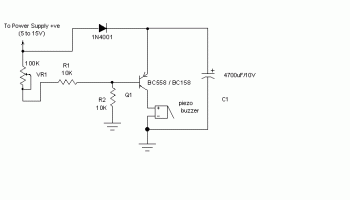This is an power supply failure alarm which will give you an alert when the power supply getting off or fail to supply. It employs an electrolytic capacitor to store adequate charge, to feed power to the alarm circuit which sounds an alarm for a reasonable duration when the supply fails.
To calibrate the circuit, first connect the power supply (5 to 15V) then vary the potentiometer VR1 until the buzzer goes from on to off.
Whenever the supply fails, resistor R2 pulls the base of transistor low and saturates it, turning the buzzer ON.
Take a note that this circuit will be work only on power supply with output voltage 5 - 15 Volt DC.
Source: http://www.electronic-circuits-diagrams.com/alarmsimages/alarmsckt2.shtml

Comments